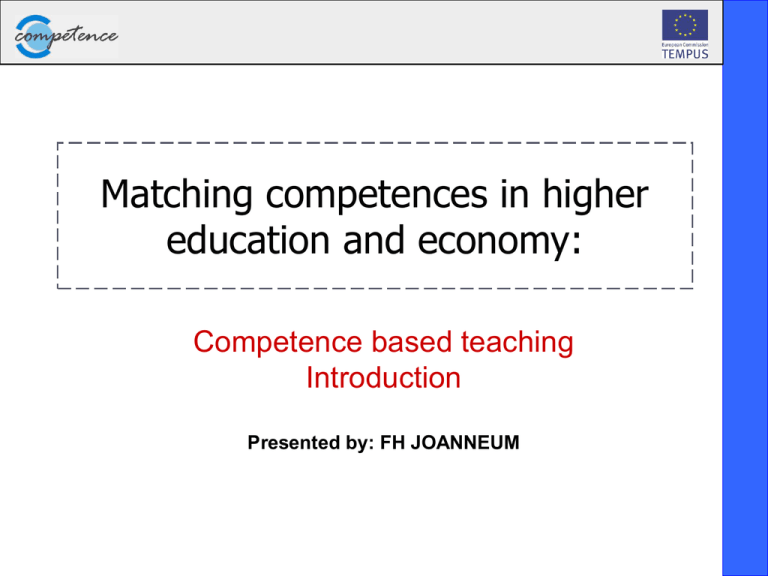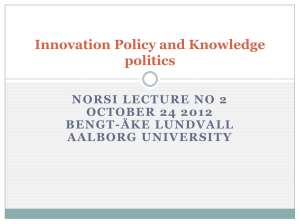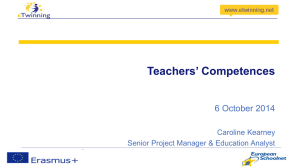Teaching_Kit_1_Competence_Intro - Link
advertisement

Matching competences in higher education and economy: Competence based teaching Introduction Presented by: FH JOANNEUM Questions and Aims: Why do we need it ? - What is it ? - How does it work ? "With labour markets increasingly relying on higher skill levels and transversal competences, higher education should equip students with the advanced knowledge, skills and competences they need through their professional lives.“ (The Bologna Process 2020) Aims Competence Based Teaching Project From 2009 to 2011 project partners from HEIs from Austria, Belgium,Bosnia & Herzogina, Mazedonia,Montenegro,Serbia and Spain are cooperating for the achievement of the following main goals: • • • • • • Development of an applied methodology for assesing the match between competences developed in higher education programmes and those required in the labour market Foundation of 4 Competence and Observation Centers Conducting 8 pilot studies Development of "Competence Catalogues“ Dissemination of project philosophy, approach and results Assurance of sustainability The Competence Project The Please add here what was already done at your university and describe how it worked: The Competence Project Success Story 1: Why do we need it ? Why do we need it? Working with competence based teaching makes it easier to set up curricula, to define learning outcomes and to compare the content of different courses. Competence based teaching is, even though it does, as all new tools require some additional work at the beginning, very helpful for reducing the workload in the planning phase of courses. Easier curriculum set-up Comparing courses with each other is much easier and overlapping can be better avoided Saves time for each professor on the long run 1: Why do we need it ? Making course design more efficient Leading universities all over Europe actively apply the concept of competence based teaching for their programs and research. Competence based teaching has become a necessary precondition for cooperation and comparison with these universities and a major element of the European higher education area. Up to date teaching methodology Increased international comparability and cooperation Teaching will be closer to EU standards 1: Why do we need it ? International comparability With the introduction of the Bologna process, many EU universities have experienced increased interest from the professional and commercial sectors Competence based teaching has proven to be the most efficient tool to establish a strong connection between higher education and employers especially if this connection was not well estabilished before. Better alumni employability Increased cooperation with industry Teaching will be more directly connected to practical use 1: Why do we need it ? A strong link to employers and alumni What is it? The International Board of Standards for Training and Performance Instruction (IBSTPI) defines a competency as “a knowledge, skill, or attitude that enables one to effectively perform the activities of a given occupation or function to the standards expected in employment” A knowledge, skill or attitude to effectively perform to the standards expected in employment 2: What is it? What are competencies? A competency includes both means and an end. The means are a combination of knowledge, skills, or abilities and the end is to perform effectively the activities of a given occupation or function to the standards expected in employment. The core of competency-based curriculum design is to ensure that learners will be able to demonstrate their learned competences after they have acquired a necessary combination of knowledge, skills, and abilities. Means: Knowledge, skills or abilities End: To perform effectively 2: What is it? What are competencies? We differentiate two main groups of competences: the general or transversal competences which are applicable to any field of knowledge Example: • Self and Time Management (i.e., ability to organize oneself, one’s time and schedule effectively and reliably) and the specific competences which are dependent on each field of knowledge. Examples: • Design control systems and industrial automation • Evaluate the environmental and landscape quality of an area 2: What is it? What are competencies? How does it work? 3: How does it work Define / Adapt Competences Evaluate Impact Assess the match Competence Matrix As a first step specific and general competences need to be defined for each degree program. There is a number of relevant stakeholders / sources which should be involved in this process, ideally in the form of focus groups. National legislation EHEA requirements Labour market needs University and acadmemic prerequisites Student needs 3: How does it work Defining competences Design/adapt a questionnaire for assessing match between skills and competences developed and those actually needed in specific jobs. To do this a questionnaire for alumni and one for employers should be used. Asess the match Alumni questionnaire Employer questionnaire 3: How does it work Assessing the match Analyse the data from the questionnaire to develop meta-level indicators, which can be used to provide feedback for curriculum design or adaptations. Aggregate Data Alumni questionnaire Employer questionnaire 3: How does it work Analyse Data Based on the results of the survey a matrix for curricula is developed. All subjects taught in a program are matched with the competences graduates should have when they finish their studies. The columns show all subjects of the degree program, the rows the competences. Competence 1 Subject 1 Subject 2 Subject (n)… Competence 2 Competence 3 Competence (m)… 3: How does it work Competence Matrix Evaluation of the impact is vital for increasing the quality of the involved learning activities and for closing the gap between industry and academia. Define / Adapt Competences Assess the match Evaluate Impact Competence Matrix 3: How does it work Evaluation More information can be found in: the Competence Manuals, the Competence website (http://www.link-competences.org/) and at the competence centre. Presented by: myname@myprovider.com Thank you very much for your attention!






